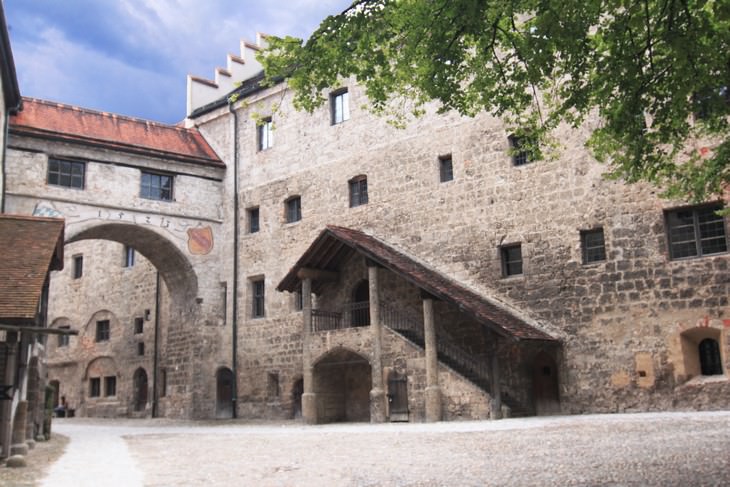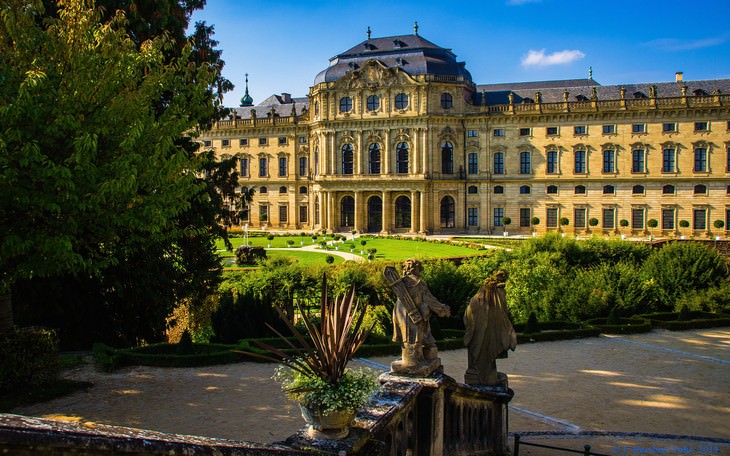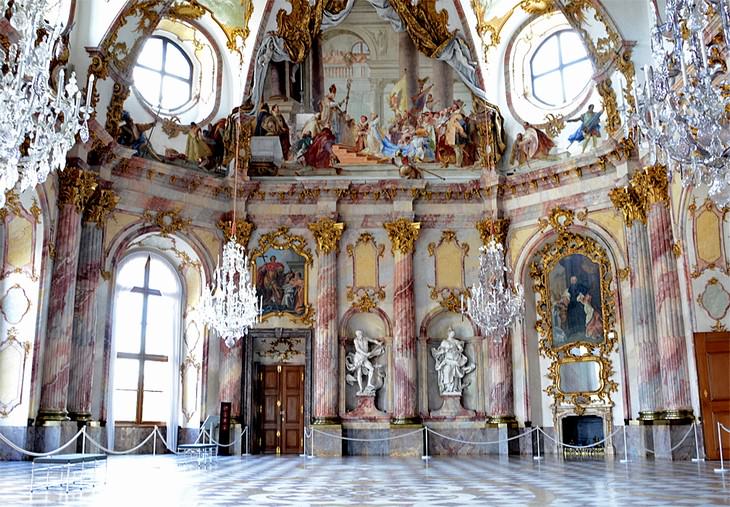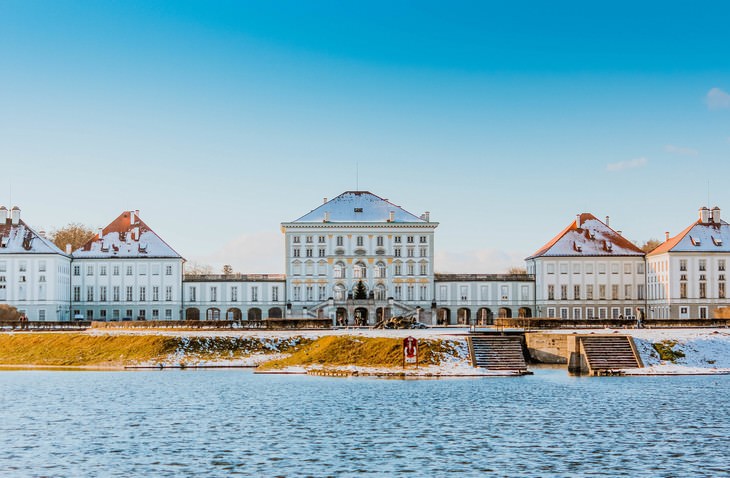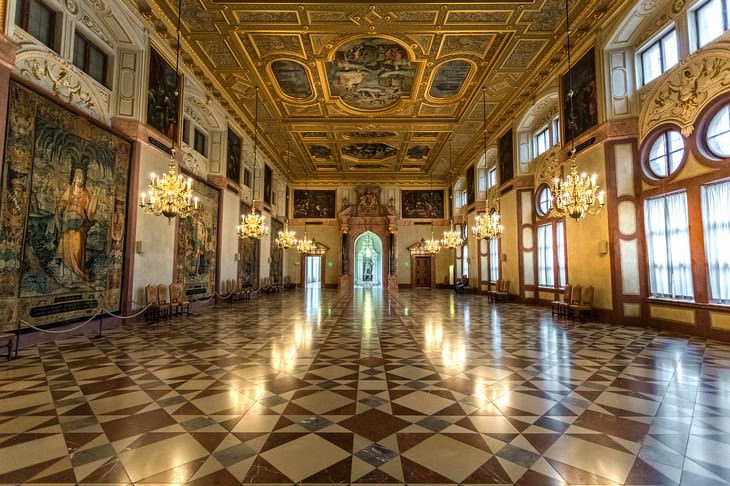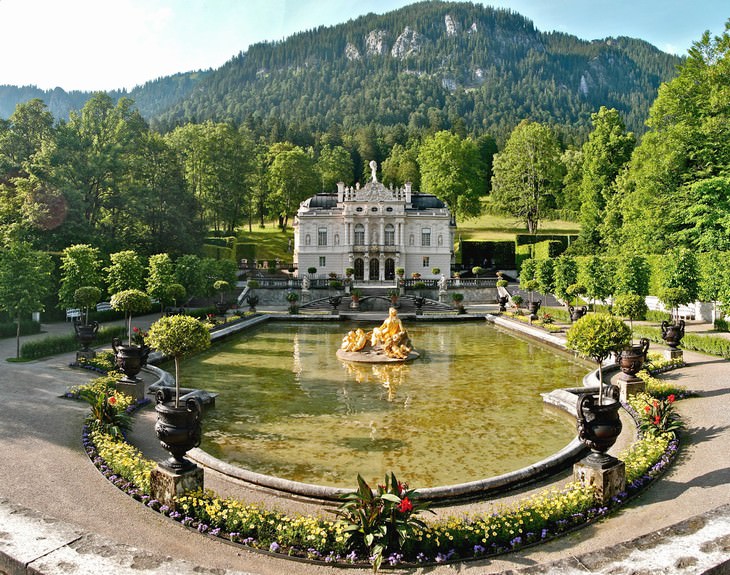1. Neuschwanstein Castle
Considered one of the most beautiful castles in the world, Neuschwanstein is also the most visited one. Apart from being a work of art by itself and famously inspiring the Disney logo, Neuschwanstein offers an unbelievably picturesque view onto lake Alpsee. The castle is situated on a hill not far from Schwangau village, and booking a tour to the castle ahead of time is the only way to visit Neuschwanstein.
Despite its resemblance to a medieval fortress, Neuschwanstein was built in the 19th century at the initiative of Ludwig II, the king of Bavaria infamous for being more interested in building beautiful palaces than ruling his kingdom. The king commissioned the castle in honor of Richard Wagner, the famous German composer, and the interior of the castle is full of frescoes depicting myths and legends that inspired Wagner’s operas.
2. Herrenchiemsee Palace
Yet another of King Ludwig’s lavish commissions, Herrenchiemsee is an exquisite palace located on an island, namely Herreninsel, the largest island in lake Chiemsee. The palace was erected in place of an existing monastery and being the last of King Ludwig’s projects, it was never completed.
And if you think that this palace doesn’t look particularly special from the outside, keep in mind that it has an absolutely luxurious interior, as it was meant to be a replica of Versaille, which the so-called Fairy Tale King visited and meant to replicate for himself. One of the most outstanding elements of the palace is the Hall of Mirrors, a nearly identical, but even larger copy of the one found in Versailles.
3. Hohenschwangau Castle
Built in place of the 12th-century Schwangau fortress, this is another 19th-century castle, and it’s situated only a 15-minute walk away from the first castle on our list, Neuschwanstein, which is why the majority of tourists visit both castles simultaneously.
Surprisingly, this particular castle wasn’t built by Ludwig II, it was, however, where he grew up. Hohenschwangau was commissioned by King Maximilian II of Bavaria, Ludwig’s father. The castle was traditionally the royal family’s summer residence and remained in their possession until after World War II.
4. Burghausen Fortress
The oldest castle on our list, Burghausen was built around 1025 or even earlier as a means of protection against the Turkish invasion. Burghausen lies on the Salzach river close to the Austrian border, and it’s the largest fortress in Germany and the longest castle in the world.
Burghausen is a true medieval fortress and looks nothing like the heavily adorned and fairy-tale-like Romanesque castles we’ve introduced earlier. So if you want to visit a real gothic castle in Bavaria, Burghausen is your best bet.
5. The Würzburg Residence
Northern Bavaria is nearly as rich in majestic palaces and castles as the southern part of the region, and the Würzburg Residence located in the city of Würzburg is the prime example. The palace is executed in the German Baroque style, and its construction dates back to the 18th century.
The Würzburg Residence is one of the many UNESCO World Heritage Sites in Bavaria, and it’s renowned for the luscious gardens, grand staircase and the largest ceiling fresco in the world created by Venetian painter Giovanni Battista Tiepolo depicting the four continents of the world (Europe, America, Asia, and Africa).
6. Nymphenburg Palace
Situated in the heart of Munich, the capital of Bavaria, is the Nymphenburg Palace, also known as the Castle of the Nymph. Built in the second half of the 17th century, Nymphenburg is a Baroque palace created by the Italian architect Agostino Barelli as per the request of the prince-elector Ferdinand Maria and his wife, Henriette Adelaide of Savoy, the former rulers of Bavaria.
The palace is a national treasure and the most popular tourist destination in Munich. Apart from the abundance of architectural splendor, the palace features extensive gardens, a huge collection of European art and precious belongings, as well as houses 5 museums. It is the second most visited place in Bavaria after Neuschwanstein castle.
7. Linderhof Palace
The third and smallest commission of Ludwig II of Bavaria is Linderhof Palace, the only one of his three projects that Ludwig would see completed before his mysterious death in 1886. The king converted the family hunting lodge near Ettal Abbey into a mini version of Versailles, and the influence can be seen throughout the stunning gardens with gold fountains, waterfalls, and terraces, to the exquisite interior of the palace.
The rooms in the palace are executed in different styles, from the large bedroom heavily inspired by the one in Versailles to the two tapestry rooms executed in Eastern (traditional Moroccan) and Western (French Gobelin) styles. There is even a man-made cave with a secret entrance that has an artificial lake inspired by Wagner's operas, where the king reportedly loved to sail on his boat. If you’re curious to see it and learn about the life of Ludwig II, we recommend you watch the bonus video below.







